Fall Clothing Styles Summary 1922

A superb summary of styles for the Fall 1922 season from Dry Goods Economist covers Silhouettes, Sleeves, Suits, Coats, Furs, Skirts, Blouses, Fabrics, Millinery (Headwear), Children's Wear, Lingerie, Corsets, Gloves, Neckwear, Veils, Hosiery, Laces, Trimmings, Ribbons, Handkerchiefs, Bags (Purses), and Jewelry.
The Silhouette
The Characteristic silhouette for fall is tall, straight and slim. There are rumors and already some representation of fuller skirts. Later developments may bring about greater width at the hem.
Dresses are very long, ranging from 5 to 7 inches from the ground. Uneven hem lines increase the length. Draped effects are very prominent, and the low waistline continues to be strongly emphasized. Many coat dresses are shown.
Sleeves
All sleeve lengths are represented in dresses. The most radical change is the revival of the long tight sleeve set into a regular armhole. Gauntlet cuffs are used on some of these sleeves, while others are shaped into a point over the hand. In general, the collarless neck obtains.
A new neck outline resembles the bateau but is squared at the shoulders. The bateau neckline continues to be in good standing, and the pointed neck also is used.
Suits
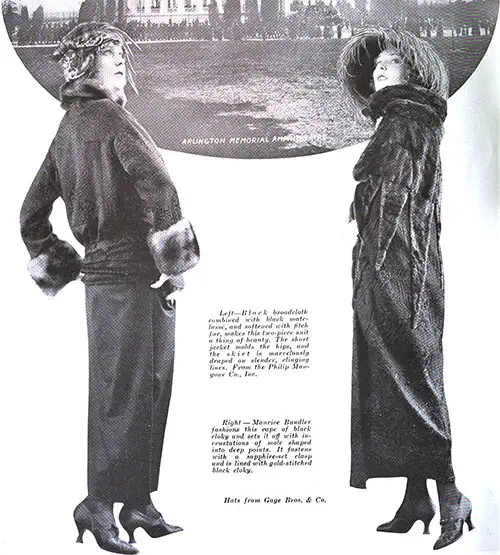
In suits, the three-piece design prevails. The dress usually has a corsage of crêpe and a draped skirt set on at a low waistline, with or without a girdle. The jackets of these suits vary in length and style. Fur trimming is employed often for the three-piece design.
Coats
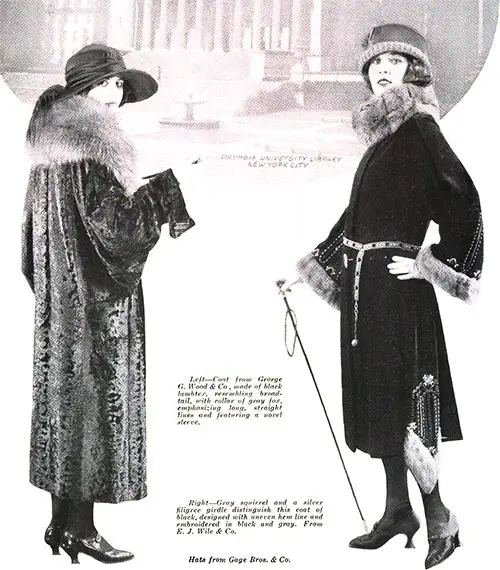
The season's coats conform more or less to the straight silhouette, except that the prevalence of "wrappy" models tends to widen the figure at the waist. The uneven hemline is featured, produced by side panels, or pointed outline at the lower edge each side, and similar treatments.
Collars of coats and suits are mostly on the choker order and are large and prominent. Almost all collars are of fur. Metal clasps and buckles are often used in place of buttons.
Furs
Fur used for trimming both coats and suits include fox, wolf, caracul, squirrel, beaver, mole, fitch and monkey.
Materials are mostly on the border of duvetyn or velvety surfaced fabrics. Exceptions to this are the matelassé and cloaky (a new Rodier fabric, is satin stitched to give a quilted effect) materials. Black is much used, also brown, dark blue, taupe and a soft brick red called Genoese.
Skirts
Separate skirts for sportswear incline to plaids, and more to the stitched-down than the wrap-around effects. Eponge, Prunella, and novelty weaves are seen. Sweaters are divided between slip-on and Tuxedo models, in silk, silk and wool, Shetland and brushed fleece.
Blouses
The over-blouse is treated in one of two forms. It may be finished with a close-fitting section at the hip, with fullness above, or can be cut straight to the hip and completed with a Separate belt.
Fabrics
Materials most in use for dresses are velvet, matelassé, and crêpes of all sorts, especially marocain, Romain, Renée, georgette, Paulette, Canton, and crêpe de Chine.
Metal fabrics, tissues, and brocades are substantial, especially silver. All Over laces are also used dyed and black, and much silver lace.
Among the wool dress materials, twill is prominent. Serge has some representation, also duvetyn and kasha. Braid is often used, both the flat braids and soutache. Steel buttons, metal trim, and touches of red or green are also featured for this type of dress.
Millinery (Hats)
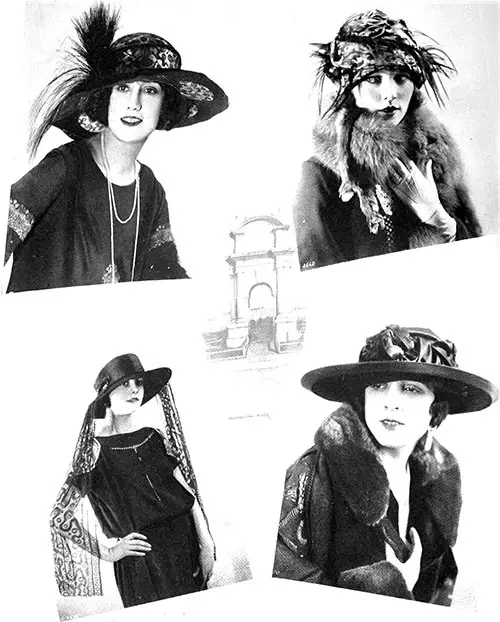
A great deal of metal and tinsel trimming is used in the fall millinery, in the form of brocades, ribbons, flowers, and Ornaments. Silver is preferred to gold.
Silk plush makes a great many shapes, and velvet is prominent, also plain and blistered satins, and felt. The large hat is considered the smartest vogue, either in the flat cartwheel shaping or mushroom type.
Short back effects are being featured. Brims are decidedly irregular in many models. They are often slashed, fluted, turned back, bent into novel outlines, and made in double and triple tier effects.
A great deal of velvet ribbon is used for trimming, especially on felt hats. Cocardes of faille or grosgrain ribbon trim simple models. Fur is frequently seen, such as mole, ermine, and monkey.
Black is prominent in fall millinery. Browns are suitable, including taupe and cocoa. Royal blue is combined with black. Green in Vert-de-Gris, Reseda, and jade, is much used for trimming.
Children's Wear
The straight-line frock and coat continue in favor for the autumn. Soft materials in rich and somewhat dull shades are used for the more exceptional coats, which are almost always trimmed with some variation of fur.
Beaver and nutria are much in evidence for every day, and school wear, plaid back coatings are popular, and these usually follow a sports model with adjustable collar, inverted box pleat in the back, and raglan sleeves. Little girls' dresses follow the lines of the chemise frock.
Except for sturdiest wear, hand-made hats showing shirring or soft folds are seen most frequently, and if there are a sash and streamers, these are almost always set on the right side.
Lingerie
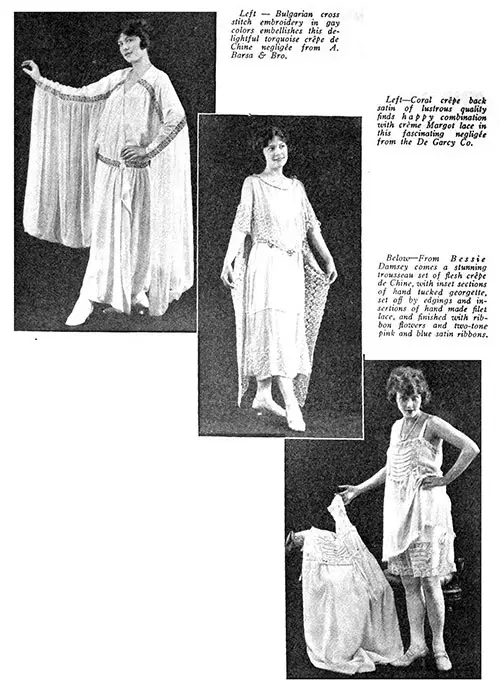
Color distinguishes the lingerie for fall in rich and deeper shades than for spring. The new lines are even more colorful than usual, and darker shades and deeper tones characterize the winter offerings. Orchid, pink, and honey-dew continue in favor, while very little blue or white are seen in the silk lines.
Applique and embroidery in coarse silks is the favored trimming, and except for trousseau sets, the lace used is generally of definite pattern and a creamy hue. Ribbons are seldom used. There is little difference in cut to any of the more exceptional garments.
Corsets
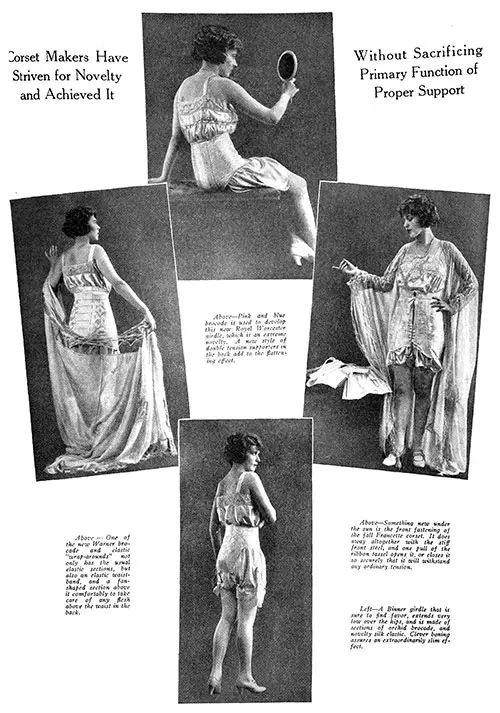
Quite a bit more boning distinguishes the new corsets for autumn, but the new garments are none the less soft, flexible and modeled on graceful lines. Low top models continue in favor, and what bones are used, are placed to give flexible support with very little restraint.
There is a growing feeling that elastic must be combined with boned sections of fabric to gain the best results, and this has led to many lines of laceless corsets and girdles which are both comfortable and good looking.
For winter wear the bandeau style of brassiere offers many attractive modifications in combination with elastic and silk jersey.
Gloves
The strap wrist glove has lost none of its popularity, but it is being made longer, in 8-button length. Practically all leathers, including the suede finish, are used.
The mousquetaire glove in 8 and 12-button styles is believed to be a good selection for fall. Both the suede and the glacé finish are considered to be in demand. Tailored styles and sportswear will feature the slip-on and the one-clasp type, in leathers like a cape, mocha, buckskin, and pigskin.
Fancy kid gauntlets are showing a great deal of decoration, including fringe, beads, embroidery, and insets of contrasting leather.
Two-tone effects are usual. Cuff linings in leather and silk are used. The gauntlet may fasten with strap or clasp or be in slip-on style. The fabric gauntlet follows the form and detail of the leather gauntlet very closely.
The fabric is fringed on occasion, inset with contrasting fabric, or embroidered.
The prominence of brown furs gives prominence to brown tones in fall gloves. Some gray gloves will be demanded, particularly in suede, and fawn and the lighter tan shades are sure to be good.
Buckskin gloves in slip-on, strap wrist and one clasp styles will be featured for tailored and sportswear. Mocha gloves are being produced in fawn and other delicate shades. There is some expectation that lace mitts will be worn with evening dress.
Neckwear
The deep cape collar of the bertha type or a modified adaptation seems to predominate in showings of advance fall models.
Plain and embroidered net combined with Irish is much used, and the combination of several different kinds of real laces is gaining impetus. Binche, Point de Venise, and Valenciennes are favorites.
Veils
The made veil, lace trimmed or embroidered in border effect continues to be very popular and is in demand in both yard squares and narrow panels.
Fancy mesh combinations, two or three together, are thought to be smart for face veils and are developed in all the staple shades, taupe, and tâte de négre being particularly useful.
Hosiery
Darker colors predominating in fabrics for streetwear indicate a similar trend in hosiery shades. Brown should be the best color, fawn, and tan as well as soft grays being suitable for afternoon wear.
Light, soft tones of green, blue, purple and red are favored most for the evening. In sports hose the same tendency is notable, subdued shades having the call in both solid colors and mixtures. Fine, lightweight qualities of wool, and silk and wool mixtures are regarded as better than are the heavy wool hose.
Fine mercerized goods are gaining, but until the longer skirt is more noticeable in the general run of women's clothes—which it is not as yet—they will hardly make a dent in silk hosiery sales.
Laces
A woven metal lace in large and distinctive design is the newest note in fall styles, and silver leads gold in popularity with scarcely any copper being shown at all.
The same type of ciré laces worn last year, except that in some instances they are wrought in two tones, are used for afternoon and dinner wear, while Chantilly continues in favor for skirt and arm drapes.
For blouses, Irish crochet and filet are both used, but Irish crochet leads in style. It also is the leading lace for lingerie, with Vals a close second.
Trimmings
Spangled and beaded robes, especially in the more robust designs, offer stiff competition to laces for formal wear. Panels, flounces, bands and motifs of spangles, and beads and spangles combined, are shown on practically every formal frock.
For waistline trimmings, fruits and flowers, very large and very unusual in color, make effective contrasts to the straight line, one toned garment.
The great vogue for metal for the coming season is felt in these trimmings, and many of these flower and fruit girdles are made entirely of silver or gold. Braids, fur or embroidered bands trim the newest street costumes with buttons and clasps of various materials, huge in shape and distinctive colors as the highlights.
Ribbons
For fall only what are known as staple ribbons are being shown. Taffetas, satins, grosgrain and other plain silks in very soft weaves and a wide range of plain and two-toned colors are used on many new frocks.
For millinery, narrow novelty ribbons in a combination of velvet or chenille, and plain silk edged or shot with metal are leading the style.
Handkerchiefs
There is still a strong tendency toward colors, even in the most excellent grade of linens, although the colors are solid and are only relieved by a bit of embroidery in one corner.
The cheaper lines are tending away from the eccentric designs shown a few seasons ago to the solid colors and plainer decorations. Some fine linen squares, both in white and in colors, are shown edged with net footings embroidered with dots to match the color of the handkerchief.
Bags (Handbags)
The large beaded bag will be the one worn with the fall suit. Daily the beaded bags are getting more substantial in size. Straight tops are perfect. Oriental, Persian and Paisley designs are woven in. The small square beaded envelope remains the favorite change purse.
Tans and grays are good in coarsely mottled leather. Strictly tailored seal purses are enormous, with more room than ever before. Braided handles are seen on all fabric bags. Marcasite ornaments both leather and fabric bags.
Jewelry
The season is a white one, rhinestone and crystal predominating. Earrings are longer. Coral is growing in favor. Pendants are enormous, and the cut-out silhouette is a winner both in ivory and metal.
All pendants are worn on the black cord of silk, except where cord and pendant match in color. Combs are high and wide. Large jet combs are good for the evening. Wristwatches are smaller, and both the watch and the bracelet are narrower.
“The Fall Style Summary,” in Dry Goods Economist: American Styles Number – World Wide Edition, New York: Textile Publishing Co., 76th Year, No. 4072, Saturday, 22 July 1922, p. 29, 217.
Note: We have edited this text to correct grammatical errors and improve word choice to clarify the article for today’s readers. Changes made are typically minor, and we often left passive text “as is.” Those who need to quote the article directly should verify any changes by reviewing the original material.

